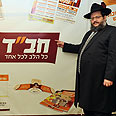
Ender with new logo: We want single identity
Some 500 Chabad officials met in the Carmel this week in an effort to create a single, solid image for their organization. For the first time in Hasidic history, public relations experts have been employed to market the group's spiritual product.
"It has been our aim forever, and we are called emissaries because we spread the word of Judaism whenever and wherever it is possible."
"The top goal of all of Chabad's members is to distribute the wellsprings of Judaism to Jews throughout the world," said Chabad spokesman Rabbi Moni Ender, who organized the convention.
The Other Side
Yoav Zitun
Ron Huldai slams haredi movement's activity in Ramat Aviv neighborhood, says 'their inappropriate behavior should be condemned'
Rabbi Menachem Mendel Schneerson, the much-admired Hasidic leader, stressed marketing as a central aim in Chabad. He sent emissaries to establish centers throughout the globe, some 4,000 of which exist today, in order to reach out to secular Jews in a manner in which no one had thought to do in the past.
Missions continued after his death in 1994, but the various centers were left to create their own marketing strategies. This eventually spawned various logos, signs, and slogans that differ drastically from each other – basically an advertising malfunction.
The new labeling and marketing initiative was brought up by the younger generation. "We want to create a single identity," says Ender. "We want people to recognize from afar every vehicle, menorah, or center. Just as Orange has the color orange and Cellcom has purple, we want a unified identity too."
Chabad is also up against some stark competition. "There are many organizations, welcome as this may be, who are operating in the field, such as Braslow and Shas. We are the strongest, largest, and oldest organization so we want to be separate from the rest," Ender explains.
The Hassidic group thus decided to appeal to the Shalmor Avnon Amichay marketing firm as well as Advantage, which surveys consumer behavior. The move has been estimated at a cost of tens of thousands of dollars, but Chabad members are unwavering, vowing to look at things in a new light – every backpacker who enters the Bangkok center to light Hanukkah candles, every traveler in India who wants to say a prayer, is now considered a customer.
'No difference between soft drinks, religion'
The marketing of Chabad is a historical move so original it is perhaps best demonstrated by the mere sight of 500 dark-suited men, each wearing the traditional Hassidic hat, listening with entranced fervor to a secular marketing specialist dressed in a sweater and jeans.
"I think maybe it was the so-called rift between Chabad and the daily lives of advertisers from Tel Aviv which allowed them to get into the heads of our clients," explains Rabbi Glitzenstein, who now sits on the marketing committee in addition to serving as a Chabad envoy in northern Tel Aviv.
Dr. Tomer Baklash, of Advantage, was pleased with the endeavor. "There is no difference between a company selling soft-drinks – in need of marketing to differentiate itself from all the other soft-drink companies out there – and the need of a Hassidic organization such as Chabad, which is interested in convincing the public to study Judaism and perform good deeds," he says.
Baklash explained the principles of marketing during his lecture before the men. "The goal is to first acquire an outstanding image, to create maximum resonance about Chabad as the top authority in bringing hearts together, helping others, and disseminating Judaism and Hassidic principles," he said.
Chairman of the Chabad Youth Organization in Israel, Rabbi Yosef Yitzhak Aharonov, says the organization had always been marketing-oriented.
"In 1969, when the first Chabad center in the world was established, Rabbi Lubavitch told us, 'There will be many more centers and you shall call them by one name, like a chain of department stores everyone recognizes for their products'," he recounted.
The new Chabad logo, which has been colored yellow, crimson, and orange, is intended to broadcast harmony and a 'back-to-roots' feeling as well as high-spiritedness. It will be used on everything the center builds, gives away, and distributes, even on the emissaries' email signatures.
So next time you're in Honolulu or Vietnam and in need kosher food, a Shabbat meal, or just a few Hanukkah candles, look for the Chabad logo, a sign that even a 300-year old tradition can modernize its goals every now and again.
- Follow Ynetnews on Facebook















